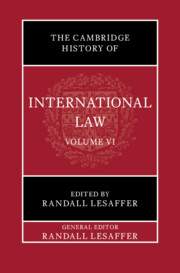Book contents
- The Cambridge History of International Law
- The Cambridge History of International Law
- Frontispiece
- The Cambridge History of International Law
- Copyright page
- Contents
- Plates
- Contributors
- Preface
- Abbreviations
- Part I International Law in Renaissance Europe (1492–1660)
- Part II International Law in Old Regime Europe (1660–1775)
- 12 The Law of Nations in Old Regime Europe
- 13 Territory and Jurisdiction in Old Regime Europe
- 14 The Law of the Sea in Old Regime Europe
- 15 War and the Use of Force in Old Regime Europe
- 16 Warfare on land in Old Regime Europe
- 17 Maritime Warfare in Old Regime Europe
- 18 Peacemaking in Old Regime Europe
- 19 Trade in Old Regime Europe
- 20 Diplomacy in Old Regime Europe
- 21 Dispute Settlement in Old Regime Europe
- 22 The Ottoman Encounter and the Law of Nations in the Old Regime
- Index
- Plate Section (PDF Only)
- References
22 - The Ottoman Encounter and the Law of Nations in the Old Regime
from Part II - International Law in Old Regime Europe (1660–1775)
Published online by Cambridge University Press: 22 April 2025
- The Cambridge History of International Law
- The Cambridge History of International Law
- Frontispiece
- The Cambridge History of International Law
- Copyright page
- Contents
- Plates
- Contributors
- Preface
- Abbreviations
- Part I International Law in Renaissance Europe (1492–1660)
- Part II International Law in Old Regime Europe (1660–1775)
- 12 The Law of Nations in Old Regime Europe
- 13 Territory and Jurisdiction in Old Regime Europe
- 14 The Law of the Sea in Old Regime Europe
- 15 War and the Use of Force in Old Regime Europe
- 16 Warfare on land in Old Regime Europe
- 17 Maritime Warfare in Old Regime Europe
- 18 Peacemaking in Old Regime Europe
- 19 Trade in Old Regime Europe
- 20 Diplomacy in Old Regime Europe
- 21 Dispute Settlement in Old Regime Europe
- 22 The Ottoman Encounter and the Law of Nations in the Old Regime
- Index
- Plate Section (PDF Only)
- References
Summary
Between 1660 and 1775 the number of European countries with diplomatic relations with the Ottoman Empire that obtained ahdames of their own grew rapidly, but many of these newcomers did not establish networks of consulates and vice-consulates in the eastern Mediterranean. Instead, they appointed the consuls of other European nations as their vice-consuls. This did not hurt the legal privileges of the merchants from these countries. In the course of the seventeenth and eighteenth centuries, some nations asked the Ottoman government to renew their capitulations several times with the single aim of obtaining more privileges. This development culminated in the French capitulations of 1740, which incorporated the clauses of virtually all earlier ahdnames. In the eyes of many Ottomans, the capitulations of 1740 came to symbolise the Europeans’ ceaseless attempts to obtain more and more privileges from the Turks. But the French renewal of their capitulations in 1673 already laid the foundations for the rise of imperialism. It was then that the Ottoman authorities granted Ottoman subjects working for foreigners as interpreters or as warehousemen the same fiscal and legal status as the Westerners. It was also in 1673 that the French had their role as protectors of the Christian Holy Places in Jerusalem, as well as of all Catholic clergymen – not just Western missionaries, but all Catholic clerics – in the Levant codified in their capitulations. It was this French model that the Russians used in 1774 to claim their own protectorate over all Greek Orthodox Christians in the Ottoman realm.
Keywords
- Type
- Chapter
- Information
- The Cambridge History of International Law , pp. 711 - 737Publisher: Cambridge University PressPrint publication year: 2025

